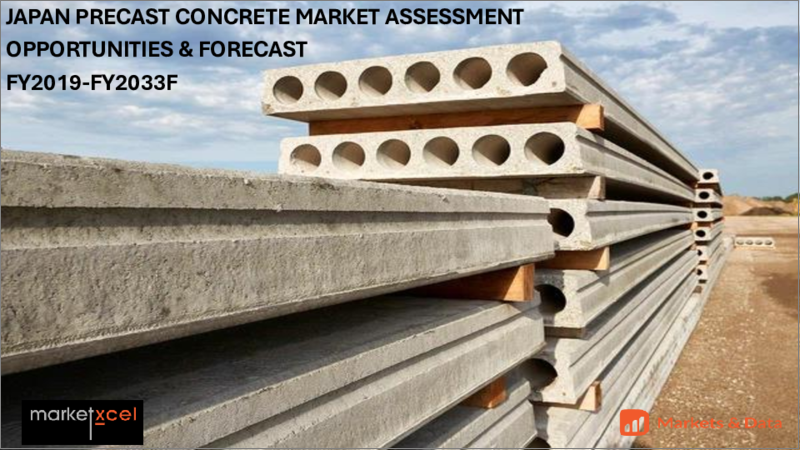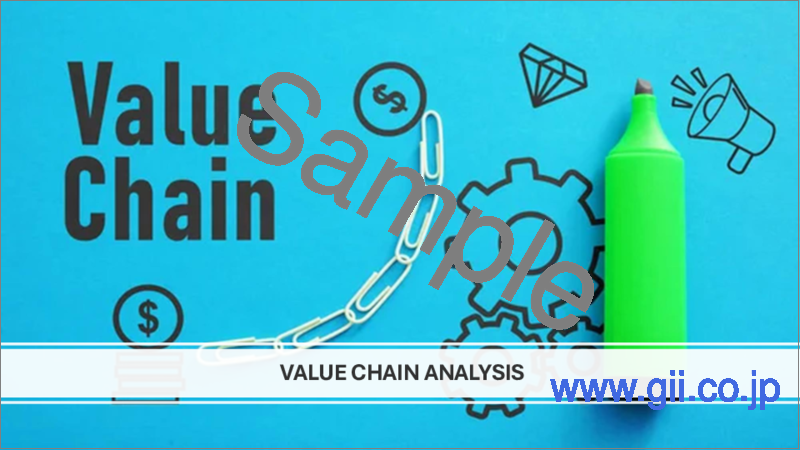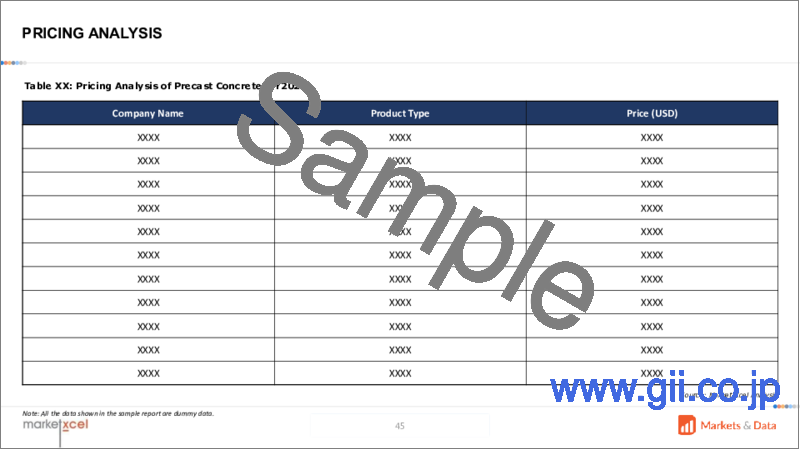|
|
市場調査レポート
商品コード
1697889
日本のプレキャストコンクリート市場:製品タイプ別、タイプ別、用途別、エンドユーザー別、地域別、機会、予測、2019年~2033年Japan Precast Concrete Market Assessment, By Product Type, By Type, By Application, By End-user, By Region, Opportunities and Forecast, FY2019-FY2033F |
||||||
カスタマイズ可能
|
|||||||
| 日本のプレキャストコンクリート市場:製品タイプ別、タイプ別、用途別、エンドユーザー別、地域別、機会、予測、2019年~2033年 |
|
出版日: 2025年04月08日
発行: Markets & Data
ページ情報: 英文 129 Pages
納期: 3~5営業日
|
全表示
- 概要
- 図表
- 目次
日本のプレキャストコンクリートの市場規模は、2026年~2033年の予測期間中に4.15%のCAGRで拡大し、2026年の63億5,000万米ドルから2033年には87億9,000万米ドルに成長すると予測されています。日本のプレキャストコンクリート市場は、建設部門がコスト効率のよい高品質の建築オプションをますます好むようになっているため、着実に開発しています。
莫大な需要は、東京を含む関東圏の大規模な都市再開発工事とインフラ整備、特に耐震建築物に支配されています。災害に強い建物に対する政府の政策による促進も、住宅、商業、輸送プロジェクトにおけるプレキャストコンクリートの広範な適用とともに、採用を刺激しています。
業界の主要参入企業は、精度と効率を高めるため、ロボット製造ラインやIoT対応品質管理といった次世代生産技術に投資しています。大阪を拠点とする関西地域でも、産業とスマートシティ開発に支えられた動きが活発化しています。持続可能性もまた主要な重点分野であり、生産者は日本の環境目標の主流化の一環として低炭素プレキャスト製品を開発しています。プレキャストコンクリートの利点-建設スピード、労働力依存の軽減、耐久性の向上-は、日本の老朽化したインフラを近代化するための好ましい選択肢となっています。モジュラー・プレキャストシステムやセンサー一体型部材といった技術は、特に高層建築やスマート・インフラ建設において急速に普及しています。都市化の動向が続き、建設効率への関心が高まるなか、日本のプレキャストコンクリート業界は、技術開発と、持続可能性と回復力への最大の関心に基づいて成長し続けると予想されます。
例えば2024年9月、RATEC GmbHは新東産業株式会社と協力し、日本のプレキャストコンクリート市場が直面する喫緊の課題に対応するため、日本における新たな販売代理店契約を締結し、国際的なプレゼンスを多様化しました。ロボットによる金型ハンドリングや人工知能による品質管理など、RATECの高効率技術の統合を通じて、このパートナーシップはプレキャスト製造を最適化し、人的資源への依存を最小限に抑え、インフラ建設のための生産量を増やすことを目指します。
当レポートでは、日本のプレキャストコンクリート市場について調査し、市場の概要とともに、製品タイプ別、用途別、エンドユーザー別、地域別動向、および市場に参入する企業のプロファイルなどを提供しています。
目次
第1章 プロジェクトの範囲と定義
第2章 調査手法
第3章 エグゼクティブサマリー
第4章 お客様の声
第5章 日本のプレキャストコンクリート市場の見通し、2019年~2033年
- 市場規模分析と予測
- 市場シェア分析と予測
- 2025年市場マップ分析
- 製品タイプ別
- タイプ別
- 途別
- エンドユーザー別
- 地域別
第6章 需要供給分析
第7章 バリューチェーン分析
第8章 ポーターのファイブフォース分析
第9章 PESTLE分析
第10章 価格分析
第11章 市場力学
- 市場の促進要因
- 市場の課題
第12章 市場動向と発展
第13章 政策と規制状況
第14章 ケーススタディ
第15章 競合情勢
- 市場リーダートップ5の競合マトリックス
- 参入企業トップ5のSWOT分析
- 市場参入企業トップ11の情勢
- Asahi Danke Co., Ltd.
- Nippon Concrete Industries Co., Ltd
- SUMITOMO MITSUI CONSTRUCTION CO., LTD.
- ITO YOGYO CO., LTD
- PS Construction Co., Ltd.
- ABE NIKKO KOGYO CO., LTD.
- Oriental Shiraishi Corporation
- Kanto Concrete Industries Co., Ltd.
- ASAHI CONCRETE WORKS Co., Ltd.
- KEICON CO., LTD.
- Aizawa Concrete Corporation
第16章 戦略的提言
第17章 調査会社について・免責事項
List of Tables
- Table 1. Competition Matrix of Top 5 Market Leaders
- Table 2. Mergers & Acquisitions/ Joint Ventures (If Applicable)
- Table 3. About Us - Regions and Countries Where We Have Executed Client Projects
List of Figures
- Figure 1. Japan Precast Concrete Market, By Value, In USD Billion, FY2019-FY2033F
- Figure 2. Japan Precast Concrete Market Share (%), By Product Type, FY2019-FY2033F
- Figure 3. Japan Precast Concrete Market Share (%), By Type, FY2019-FY2033F
- Figure 4. Japan Precast Concrete Market Share (%), By Application, FY2019-FY2033F
- Figure 5. Japan Precast Concrete Market Share (%), By End-user, FY2019-FY2033F
- Figure 6. Japan Precast Concrete Market Share (%), By Region, FY2019-FY2033F
- Figure 7. By Product Type Map-Market Size (USD Billion) & Growth Rate (%), FY2025
- Figure 8. By Type Map-Market Size (USD Billion) & Growth Rate (%), FY2025
- Figure 9. By Application Map-Market Size (USD Billion) & Growth Rate (%), FY2025
- Figure 10. By End-user Map-Market Size (USD Billion) & Growth Rate (%), FY2025
- Figure 11. By Region Map-Market Size (USD Billion) & Growth Rate (%), FY2025
Japan precast concrete market is projected to witness a CAGR of 4.15% during the forecast period FY2026-FY2033, growing from USD 6.35 billion in FY2026 to USD 8.79 billion in FY2033. The precast concrete market of Japan is developing steadily because the construction sector increasingly favors cost-effective and high-quality building options.
Huge Demand is governed by the Kanto area, which includes Tokyo, for large-scale redevelopment work in cities and infrastructure upscaling, particularly earthquake-resistant buildings. Promotion through policies of the government towards disaster-resilient building also stimulates adoption, with widespread application of precast concrete in residential, commercial, and transport projects.
Key industry players are investing in next-generation production technology, such as robotic manufacturing lines and IoT-enabled quality control to enhance accuracy and efficiency. The Osaka-based Kansai region is also seeing increased action supported by industry and smart city development. Sustainability is also a primary area of focus, with producers developing low-carbon precast products as part of mainstreaming Japan's environmental goals. The advantages of precast concrete-construction speed, reduced labor dependency, and increased durability-are making it the preferred choice to modernize Japan's aging infrastructure. Technologies such as modular precast systems and sensor-integrated components are rapidly gaining traction, especially in high-rise and smart infrastructure construction. As the trend continues towards urbanization and with a growing focus on the efficiency of construction, Japan's precast concrete industry will keep on growing based on technological developments and the greatest concern for sustainability and resilience.
For instance, in September 2024, RATEC GmbH collaborated with SHINTO SANGYO CO., LTD. to diversify its international presence through the execution of a new sales representative contract in Japan to meet the most pressing issues facing the precast concrete market in the country. Through the integration of RATEC's high-efficiency technology, like robotics mold handling and quality control using artificial intelligence, the partnership will aim to optimize precast manufacture, minimize reliance on human resources, and increase output for infrastructure construction.
Innovation Drives the Japan Precast Concrete Market
Innovation is one of Japan's precast concrete industry's key growth drivers, which greatly increases construction quality and efficiency. New technologies developed by manufacturers, like automated lines and 3D modeling, have transformed the industry to allow high-definition quality inspections and fast assembly of parts. These technologies allow structures to be built with less manpower and construction time, meeting the infrastructure needs in the short term. Moreover, the integration of intelligent technologies within precast operations also facilitates processes more efficiently. As natural disasters worsen throughout Japan, advanced disaster-resistant construction techniques are fueling high demand for precast concrete in residential and infrastructure developments. Its established resistance to earthquakes, typhoons, and flooding makes precast concrete a top choice for Japan's future-proof building requirements
For instance, in September 2023, Japan's Concretas Co., Ltd. unveiled "Nordic Homes," the nation's first precast concrete (W-PC), externally insulated precast concrete housing system. This new solution, which utilizes factory-produced concrete panels assembled on site, tackles shortages of labor, increases construction velocity and quality, and emphasizes disaster resistance to earthquakes and flooding, energy efficiency, and contemporary aesthetics. Being Japan's trailblazing specialized precast housing system, it is a milestone in sustainable, long-lasting residential building, providing an example for resolving both population challenges and environmental requirements in the construction sector.
Sustainability Drives the Precast Concrete Market in Japan
Sustainability is the key driver in the Japan precast concrete industry, which has made a significant contribution to its trend of growth. Growing emphasis on sustainable construction practice is linked to the need for products with light environmental impacts, which increases the demand for precast concrete. Precast concrete is efficient since it involves less steel, concrete, and water than traditional processes and is thus less energy-consuming and wasteful.
Government policies promote green building, and precast elements are now being adopted more and more in infrastructure development to achieve green building certifications. The growing popularity of precast among architects and builders is also indicative of the times, as the current trend is to design and construct enduring structures that are resilient to natural calamities. All these are sustainability issues that not only drive business expansion but also make precast concrete a significant part of Japan's next building campaign.
For instance, in April 2024, a consortium of Kajima Corp., Chugoku Electric Power, Denka, and Landes Co. introduced CO2-SUICOM, an innovative product in green building materials. The CO2-absorbing precast concrete mineralizes carbon dioxide chemically during curing, sequestering emissions permanently without compromising structural strength. The precast process allows factory-optimized CO2 injection, maximizing absorption efficiency. This technology is a major step toward carbon-negative infrastructure, supporting global decarbonization efforts in the construction industry.
Non-Residential Holds the Highest Market Share
The non-residential segment is leading the majority of Japan's precast concrete market, driven by a renewed boost in infrastructure and commercial developments. This is being spurred by increasing investments in public buildings, shopping malls, and industrial schemes that seek affordable, high-quality building solutions. The advantages of precast concrete, such as speedy installation and cost reduction, also contribute to its attractiveness to non-residential applications. Similarly, the demand is propelled by the current recovery in the manufacturing industry, together with institutional building growth. With increased urbanization leading to increased construction activity, the non-residential segment leads the precast concrete industry as a reflection of strong demand for new construction methods.
For instance, in 2023, Japan's Mitsukojima Wharf, the largest salt terminal, was completed. The project underwent rapid pier renewal using innovative precast construction technology. Novel technology using super-large precast blocks with RC hollow structure that maintains the key merits of precast such as lightweight and stability.
Central Japan Dominates the Market
Central Japan is poised to be at the forefront of the precast concrete market due to growth drivers driven by expanding urbanization and huge infrastructure undertakings. Central Japan is richly endowed with manufacturing resources and state-of-the-art technology capabilities, promoting smooth manufacturing as well as superior precast products. Government initiatives to increase transport networks and public facilities also propel precast demand for solutions. Increased focus on eco-friendly construction methods further augurs well for the region's sustainable development thrusts. Therefore, Central Japan is well-positioned to lead the market, leveraging its strategic position to meet the growing needs of urban infrastructure and enhance safety and disaster resilience. The leadership is likely to continue as investment in developing infrastructure continues to rise over the next several years.
For instance, in December 2022, Murata Manufacturing Co., Ltd. established its Tokyo Logistics Center in Nagareyama city, Chiba prefecture. The structure and scale of the building are constructed with precast concrete (seismically isolated) with a steel section.
Future Market Scenario (FY2026 - FY2033F)
As urban areas expand, the demand for precast concrete will rise significantly, driven by the need for efficient and durable construction solutions to accommodate growing populations and infrastructure requirements.
Innovations in manufacturing processes, such as automation and smart technologies, will enhance production efficiency and quality, positioning precast concrete as a preferred choice for modern construction projects.
Increasing focus on environmentally friendly building practices will drive the adoption of precast concrete, as it offers reduced waste and energy consumption compared to traditional construction methods.
Favorable government policies aimed at boosting infrastructure investment will further stimulate the precast concrete market, ensuring ongoing growth and development in various sectors, including transportation and public facilities.
Key Players Landscape and Outlook
The competitive landscape of the Japan precast concrete market is characterized by a mix of established players and emerging firms. Key companies dominate the market, leveraging their extensive resources and technological advancements to maintain a strong presence.
These companies compete based on product quality, innovation, and pricing strategies, aiming to meet the growing demand for sustainable construction solutions. Additionally, smaller firms are increasingly entering the market, introducing novel technologies and innovative products to enhance competitiveness.
Strategic collaborations and mergers are common as companies seek to expand their market reach and improve operational efficiencies. Overall, the landscape is evolving rapidly, driven by technological advancements and changing consumer preferences towards eco-friendly construction practices
For instance, in September 2024, Japan's Aizawa Concrete Corporation and Saudi Arabia's Al-Saedan Ready-Mix Concrete formed a joint venture to establish a precast concrete factory in Riyadh. The new facility will manufacture precast concrete products to support Saudi Arabia's construction sector and major development projects.
Table of Contents
1. Project Scope and Definitions
2. Research Methodology
3. Executive Summary
4. Voice of Customers
- 4.1. Respondent Demographics
- 4.2. Brand Awareness
- 4.3. Factors Considered in Purchase Decisions
- 4.4. Unmet Needs
5. Japan Precast Concrete Market Outlook, FY2019-FY2033F
- 5.1. Market Size Analysis & Forecast
- 5.1.1. By Value
- 5.2. Market Share Analysis & Forecast
- 5.2.1. By Product Type
- 5.2.1.1. Columns and Beams
- 5.2.1.2. Girders
- 5.2.1.3. Floors and Roofs
- 5.2.1.4. Walls and Barriers
- 5.2.1.5. Pipes
- 5.2.1.6. Paving Slabs
- 5.2.1.7. Others
- 5.2.2. By Type
- 5.2.2.1. Wet Concrete
- 5.2.2.2. Dry/Semi-dry Concrete
- 5.2.3. By Application
- 5.2.3.1. Structural Building Components
- 5.2.3.2. Transportation Products
- 5.2.3.3. Architectural Building Components
- 5.2.3.4. Others
- 5.2.4. By End-user
- 5.2.4.1. Residential
- 5.2.4.2. Non-Residential
- 5.2.5. By Region
- 5.2.5.1. North [Hokkaido and Tohoku]
- 5.2.5.2. Central [Kanto and Chubu]
- 5.2.5.3. South [Kansai, Chugoku, Shikoku, and Kyushu & Okinawa]
- 5.2.6. By Company Market Share Analysis (Top 5 Companies and Others - By Value, FY2025)
- 5.2.1. By Product Type
- 5.3. Market Map Analysis, FY2025
- 5.3.1. By Product Type
- 5.3.2. By Type
- 5.3.3. By Application
- 5.3.4. By End-user
- 5.3.5. By Region
6. Demand Supply Analysis
7. Value Chain Analysis
8. Porter's Five Forces Analysis
9. PESTLE Analysis
10. Pricing Analysis
11. Market Dynamics
- 11.1. Market Drivers
- 11.2. Market Challenges
12. Market Trends and Developments
13. Policy and Regulatory Landscape
14. Case Studies
15. Competitive Landscape
- 15.1. Competition Matrix of Top 5 Market Leaders
- 15.2. SWOT Analysis for Top 5 Players
- 15.3. Key Players Landscape for Top 11 Market Players
- 15.3.1. Asahi Danke Co., Ltd.
- 15.3.1.1. Company Details
- 15.3.1.2. Key Management Personnel
- 15.3.1.3. Products and Services
- 15.3.1.4. Financials (As Reported)
- 15.3.1.5. Key Market Focus and Geographical Presence
- 15.3.1.6. Recent Developments/Collaborations/Partnerships/Mergers and Acquisition
- 15.3.2. Nippon Concrete Industries Co., Ltd
- 15.3.3. SUMITOMO MITSUI CONSTRUCTION CO., LTD.
- 15.3.4. ITO YOGYO CO., LTD
- 15.3.5. PS Construction Co., Ltd.
- 15.3.6. ABE NIKKO KOGYO CO., LTD.
- 15.3.7. Oriental Shiraishi Corporation
- 15.3.8. Kanto Concrete Industries Co., Ltd.
- 15.3.9. ASAHI CONCRETE WORKS Co., Ltd.
- 15.3.10. KEICON CO., LTD.
- 15.3.11. Aizawa Concrete Corporation
- 15.3.1. Asahi Danke Co., Ltd.
Companies mentioned above DO NOT hold any order as per market share and can be changed as per information available during research work.






